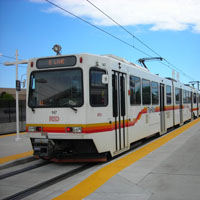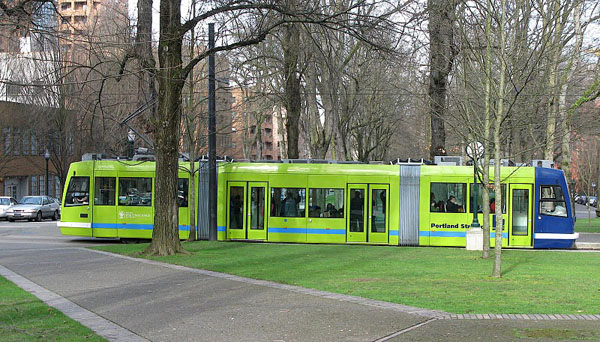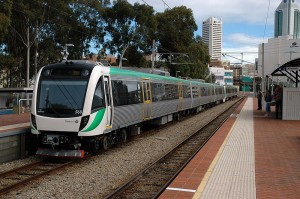To a much greater extent than with other forms of travel such as buses and airplanes, the design of the vehicles — or rolling stock — and the passenger facilities and other infrastructure are tightly integrated; the design of the vehicle has a great deal of influence on the design of the facilities that serve it. There are a wide variety of rail travel modes, ranging from streetcars running short distances on surface streets to high-speed trains running hundreds of miles, and the physical infrastructure designed to interface with these modes can vary widely. For example, the train platforms must be at least as long as the train, the platform height must match the train’s floor height in order to provide barrier-free access, and there must be no more than a 2-inch gap between the platform edge and the train’s door openings 1.
Below is a summary of the most common modes of trail transit, with the common characteristics of each. Note that these are not rigid definitions, as many rail transit systems utilize a hybrid approach that may incorporate features of more than one mode of rail travel.
Common Modes of Rail Travel
 Portland, Oregon Streetcar 2 Portland, Oregon Streetcar 2 |
Streetcar
|
 Denver RTD Light Rail 3 Denver RTD Light Rail 3 |
Light Rail
|
 Washington Metro Red Line 4 Washington Metro Red Line 4 |
Heavy Rail / Metro
|
 NJ Transit Northeast Corridor 5 NJ Transit Northeast Corridor 5 |
Commuter Rail
|
 Amtrak Empire Builder 6 Amtrak Empire Builder 6 |
Intercity Rail
|
 TGV Duplex, France 7 TGV Duplex, France 7 |
High-Speed Rail
|
Current transportation planning includes proposals to link Cincinnati to other cities in the Midwest via conventional intercity rail and high-speed rail. However, as the Metro Cincinnati project deals primarily with rail transit within the metropolitan area, these modes are outside the scope of this project. For rail transit within the region, the question then becomes: What form will a regional rail system will ultimately take?
Light Rail vs. Heavy Rail
Most of the recent proposals for rail transit within the Greater Cincinnati region, notably the 2002 Metro Moves initiative, have proposed a three-tier system incorporating commuter rail, light rail, and streetcar service. The city is proceeding with plans to build a modern streetcar line connecting downtown and the uptown area, and the streetcar line is incorporated into the Metro Cincinnati project. Planning for commuter rail and light rail have remained stalled since the Metro Moves ballot initiative was defeated.
A number of medium-sized American cities — notably Portland, San Diego, and Denver — have constructed light rail systems to serve their regional rail transit needs. Compared to modern heavy rail systems such as the Washington Metro, light rail offers a number of cost-saving benefits that allow cities to implement rail transit while minimizing upfront capital costs. These benefits include:
- Light rail lines do not need to be fully grade-separated, and often run on surface streets. This negates the need for expensive subway tunnels or elevated viaducts in built-up areas.
- Light rail trains are typically shorter than heavy rail metro trains, requiring shorter platforms and smaller stations.
- As fare collection is usually via a proof-of-payment system, light rail stations do not require fare gates and strict separation between paid and unpaid areas, nor ticket agents at each station to collect fares.
However, light rail involves a number of disadvantages compared to traditional heavy rail metro systems:
- Running on surface streets, light rail trains must contend with other street traffic, pedestrians, and traffic signals at cross streets. This can greatly reduce average train speeds and lengthen travel times.
- Light rail trains, being shorter and narrower than most heavy rail metro trains, offer substantially reduced passenger capacity than would otherwise be possible. Future expansion of passenger capacity may involve costly capital improvements (such as grade separation or lengthening of platforms) and disruptions to existing rail service.
- As ridership increases, a proof-of-payment fare system may prove inadequate, necessitating the need for fare gates. This may involve costly renovations to existing infrastructure.
With the benefits and drawbacks above in mind, the ideal scenario over the long-term leans strongly toward a heavy rail mode of transit. Given the choice between compromising long-term speed and capacity to minimize upfront capital costs, or providing the highest levels of service quality, the Metro Cincinnati project choses to err on the side of the latter option and propose a two-tier system comprised of a heavy rail metro system comparable in nature to the Washington Metro system, complimented by a network of surface-running streetcars.
Cincinnati offers a number of reasons why a heavy rail system may be the preferred approach:
- The existing subway tunnels and stations under Central Parkway are already built to heavy rail specifications, with a fully grade-separated right-of-way and high-level platforms. The existing infrastructure is very similar to what is now the MBTA Red Line serving Boston and Cambridge, Massachusetts.
- Much of the existing rights-of-way set aside for transit use in Cincinnati, including existing railroad alignments and rights-of-way along expressways, have a minimum of grade crossings.
- The city’s hilly topography favors deep-bore tunneling in several areas, as opposed to surface-running light rail transit.
A Hybrid Approach
The original objective of the Metro Cincinnati project was to provide a vision of an ideal rail transit system that could be constructed as if funding were not a limitation, and the design of the system’s physical infrastructure in this project is based on that assumption. Without drastic changes in current priorities in transportation funding at the federal level, however, it is unlikely that such a system will be built in its proposed form.
Most of the discussion about a regional rail system for Greater Cincinnati has focused on the development of a light rail system, which incorporates a number of cost-saving measures compared to the heavy rail system proposed on these pages, but at the expense of speed and passenger capacity.
However, there are measures that can be taken to combine the cost-saving measures of light rail with the capacity and speed benefits of heavy rail. Such a hybrid approach may resemble the TransPerth system in Australia, which utilizes Bombardier B-Series trainsets that are similar to Washington Metro trains in many respects, including high-level boarding and increased passenger capacity. Unlike the Washington Metro, the TransPerth trains are run via overhead catenary wires and incorporate surface-running segments with grade crossings, which eliminate the need for costly grade-separation for the entire right-of-way. Given that the existing Central Parkway subway is already designed with high-level platforms, such an approach would also negate the need for the costly reconfiguration of the subway for low-floor light rail trains. Fare collection could initially be via a proof-of-payment system, thus eliminating the need for costly fare gates and staffed stations. Provisions can be included to facilitate the future installation of a fare gate system if warranted by increasing ridership.
This amateur video shows the ride on a TransPerth B-Series train from the Mandurah to Esplanade stations:
Rapid Transit Rolling Stock
The rapid transit portion of the Metro Cincinnati proposed using rolling stock built to the same or similar specifications as the new 7000-series rolling stock posted for bid by the Washington Metropolitan Area Transit Authority (WMATA) in January 2009:
- Technical Specifications (PDF)
- Drawings (PDF)
The specifications having the greatest impact on the design of the system’s physical infrastructure are the dimensions and clearances as follows 8:
WMATA specifications call for the trains to be arranged in married pairs, in which pairs of railcars are semipermanently coupled, with operating controls located at the outer ends of the pair. The maximum train length is four pairs (eight cars) for a total length of approximately 600 feet.
The Metro Cincinnati departs from this aspect of the WMATA design, choosing instead to arrange trains into four-unit articulated trainsets with an operating cab at each end of the trainset. The articulated design allows for increased passenger capacity and enhanced security, as the articulated units allow for free passage between train cars in the event of a security and safety hazard, as well as increased visibility within the train. The maximum train length is two trainsets (eight cars), or approximately 600 feet.
Click on an image below for a higher-resolution version.
Exterior Renderings
Interior Rendering
Front Elevation
Side Elevation
Streetcar Rolling Stock
The Metro Cincinnati system proposes using a network of modern, low-floor streetcars to serve as neighborhood circulators and as feeders into the rapid transit lines. Such a streetcar system is currently under development by the City of Cincinnati, is modeled after similar projects in Portland, Oregon and Seattle, Washington using rolling stock developed by Czech Republic-based SKODA and manufactured by Oregon-based United Streetcar, LLC.
Relevant specifications are as follows 9:
Floor height (ends): 2′-6 3/4″ from top of rail
Floor height (midsection): Â 1′-2″ from top of rail
Vehicle length: 66′-0″
Vehicle width at floor: 8′-0″
Vehicle height: 11′-3″
Minimum turning radius: 60′-0″
Maximum grade: Â 9%
The passenger facilities needed for the streetcar system are minimal, and typically consist of raised curbs and sidewalk shelter structures. Â As such, the primary focus of the passenger facilities of the Metro Cincinnati system is the design of the rapid transit stations.
Streetcar Images

Portland streetcar superimposed on a downtown Cincinnati street (Image: Brad Thomas / CincyStreetcar Blog.)

Side view of a Portland streetcar (Photo: Brad Thomas / CincyStreetcar Blog.)
Notes / Image Credits
- Carl Berkowitz, “Mind the Gap: Platform-to-Railcar Gap”, transportationexpertwitness.com, http://www.transportationexpertwitness.com/MindtheGap_000.htm [accessed 17 February 2010].
- Bradley Thomas, “Proximity to Streetcar Line Already a Selling Point”, CincyStreetcar Blog, http://cincystreetcar.wordpress.com/2010/01/06/proximity-to-streetcar-line-already-a-selling-point/ [accessed 9 February 2010].
- Daniel Jennings, “Denver: RTD Dry Creek Station”, NYCsubway.org, http://world.nycsubway.org/perl/show?72704 [accessed 9 February 2010]
- David Pirmann, “Washington, DC: WMATA Red Line”, NYCsubway.org, http://world.nycsubway.org/perl/show?89937 [accessed 9 February 2010].
- Bob Vogel, “NJ Transit: Northeast Corridor Line”, NYCsubway.org, http://world.nycsubway.org/perl/show?68147 [accessed 9 February 2010].
- Jeremiah Cox, “Havre, Montana”, The Subway Nut, http://www.subwaynut.com/amtrak/havre/index.html [accessed 9 February 2010].
- Patrick Meunier, “SNCF #236”, RailPictures.net, http://www.railpictures.net/viewphoto.php?id=234890 [accessed 9 February 2010].
- Washington Metropolitan Area Transit Authority (WMATA), “7000-Series Railcar Technical Specification”, 30 January 2009, sections 1.4.2, 1.4.3.
- HDR / Parsons Brinkerhoff, “Cincinnati Streetcar Feasibility Study”, July 2007, page 9.







